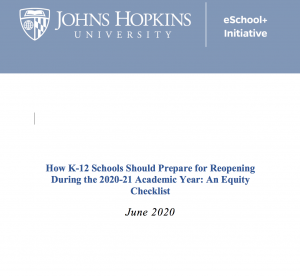A Note About School Reopenings and Equity
COVID-19 school closures have negatively impacted all K-12 students across the United States. Despite this universally detrimental impact, it is important to acknowledge that not all students have been affected equally. Students from disadvantaged groups, including students from low-income families and students of color, have faced compounded threats to their physical, emotional, and educational wellbeing during school closures, and have the most at stake as schools grapple with the difficult questions about how and when to reopen.
Before COVID-19 school closures, students from disadvantaged groups were more likely to struggle in school and have higher rates of serious health conditions. There are many reasons why these students had more chronic absenteeism, lower baseline performance scores and high school graduation rates, and poorer health than their peers, but most of these reasons can be traced to structural injustices in the basic fabric of social life.
These baseline academic and health inequities have all been exacerbated by COVID-19 school closures. Inadequate and unfamiliar technology, limited access to school-based health and food services, and, in some cases, unsafe households have left students exposed to many threats and harms that are usually blunted by vital school supports. As a consequence, the inequity gap on multiple measures of child wellbeing has widened.
As schools look to reopening and recovery, it is once again students from disadvantaged groups who will bear the brunt of the burden. They will be returning to schools with fewer resources and poorer infrastructure. As a result, it will be more challenging for these schools to implement the proposed safety and health guidelines, such as smaller class sizes, frequent cleaning of school facilities, and mental health supports that have been suggested by various organizations (Appendix 1 and 2).
A critical step in addressing the equity issues posed by school reopenings is engaging stakeholders in ongoing conversations about what could and should be done to narrow the gap in impact of COVID-19 school closures and, at minimum, lessen the risks that these particularly hard-hit students will again suffer disproportionately as school returns. Without adequately addressing reopening issues for our most vulnerable students, we face the perpetuation of this inequity cycle, both during the 2020-21 academic year and beyond.
